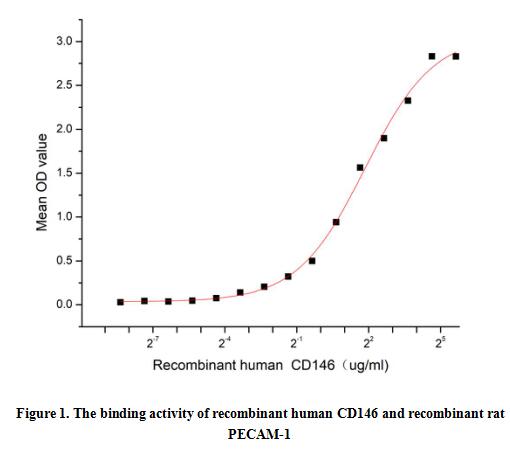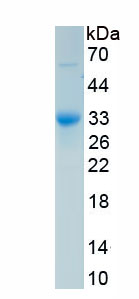Active Cluster Of Differentiation 146 (CD146) 

MCAM; MUC18; Melanoma Cell Adhesion Molecule; Cell surface glycoprotein P1H12; Melanoma-associated antigen A32; S-endo 1 endothelial-associated antigen
Overview
Properties
- Product No.APB670Hu01
- Organism SpeciesHomo sapiens (Human) Same name, Different species.
- ApplicationsCell culture; Activity Assays.
Research use only - DownloadInstruction Manual
- CategoryCD & Adhesion moleculeTumor immunityDermatology
- Buffer FormulationPBS, pH7.4, containing 0.01% SKL, 5% Trehalose.
- Traits Freeze-dried powder, Purity > 90%
- Isoelectric Point5.1
Sign into your account
Share a new citation as an author
Upload your experimental result
Review

Contact us
Please fill in the blank.
Activity test

CD146 (cluster of differentiation 146), also known as MUC18 or MCAM, is a putative adhesion molecule that belongs to the immunoglobulin superfamily (IgSF). It is an approximately 113-kDa type1 transmembrane glycoprotein that is expressed at the intercellular junction of endothelial cells. CD146 was originally identified as a tumor marker for melanoma (MCAM) due to its existence only in melanoma but not in the corresponding normal counterpart. However CD146 is not just a CAM for the inter-cellular and cell-matrix adhesion. Recent evidence indicates that CD146 is actively involved in miscellaneous processes, such as development, signaling transduction, cell migration, mesenchymal stem cells differentiation, angiogenesis and immune response. CD146 and PECAM-1 are both members of immunoglobulin superfamily of cell adhesion molecules. PECAM-1 has been identified as an interactor of CD146, thus a functional binding ELISA assay was conducted to detect the interaction of recombinant human CD146 and recombinant rat PECAM-1. Briefly, CD146 was diluted serially in PBS with 0.01% BSA (pH 7.4). Duplicate samples of 100 ul were then transferred to PECAM-1-coated microtiter wells and incubated for 1h at 37℃. Wells were washed with PBST and incubated for 1h with anti-CD146 pAb, then aspirated and washed 3 times. After incubation with HRP labelled secondary antibody for 1h at 37℃, wells were aspirated and washed 5 times. With the addition of substrate solution, wells were incubated 15-25 minutes at 37℃. Finally, add 50 ul stop solution to the wells and read at 450/630 nm immediately. The binding activity of recombinant human CD146 and recombinant rat PECAM-1 was shown in Figure 1, the EC50 for this effect is 3.6 ug/mL.
Usage
Reconstitute in 10mM PBS (pH7.4) to a concentration of 0.1-1.0 mg/mL. Do not vortex.
Storage
Avoid repeated freeze/thaw cycles. Store at 2-8°C for one month. Aliquot and store at -80°C for 12 months.
Stability
The thermal stability is described by the loss rate. The loss rate was determined by accelerated thermal degradation test, that is, incubate the protein at 37°C for 48h, and no obvious degradation and precipitation were observed. The loss rate is less than 5% within the expiration date under appropriate storage condition.
Increment services
-
 BCA Protein Quantification Kit
BCA Protein Quantification Kit
-
 Molecular Mass Marker for Protein
Molecular Mass Marker for Protein
-
 Monoclonal Antibody Customized Service
Monoclonal Antibody Customized Service
-
 Polyclonal Antibody Customized Service
Polyclonal Antibody Customized Service
-
 Protein Activity Test Experiment Service
Protein Activity Test Experiment Service
-
 Electrophoretic Mobility Shift Assay (EMSA) Experiment Service
Electrophoretic Mobility Shift Assay (EMSA) Experiment Service
-
 Buffer
Buffer
-
 Lentivirus Packaging Experiment Service
Lentivirus Packaging Experiment Service
-
 Adenovirus Packaging Experiment Service
Adenovirus Packaging Experiment Service
-
 Real Time PCR Experimental Service
Real Time PCR Experimental Service
-
 Spike RBD Protein (S-RBD)
Spike RBD Protein (S-RBD)
-
 Protein G
Protein G
-
 Protein A
Protein A
Citations
- Evaluation of various endothelial biomarkers in ankylosing spondylitisPubMed: 21556780
- The Effect of Regular Colchicine Treatment on Biomarkers Related with Vascular Injury in Newly Diagnosed Patients with Familial Mediterranean FeverSpringerLink: m7128503g576w808
- Selective targeting of liver cancer with the endothelial marker CD146Pubmed:25238265
- Melanoma cell adhesion molecule as an emerging biomarker with prognostic significance in systolic heart failurepubmed:27355366







